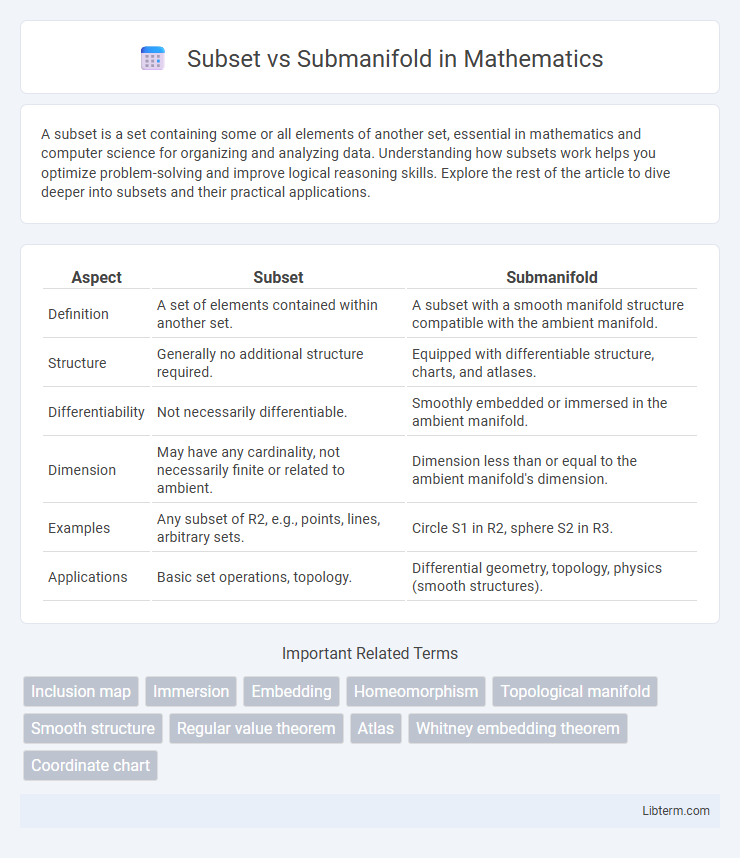A subset is a set containing some or all elements of another set, essential in mathematics and computer science for organizing and analyzing data. Understanding how subsets work helps you optimize problem-solving and improve logical reasoning skills. Explore the rest of the article to dive deeper into subsets and their practical applications.
Table of Comparison
| Aspect | Subset | Submanifold |
|---|---|---|
| Definition | A set of elements contained within another set. | A subset with a smooth manifold structure compatible with the ambient manifold. |
| Structure | Generally no additional structure required. | Equipped with differentiable structure, charts, and atlases. |
| Differentiability | Not necessarily differentiable. | Smoothly embedded or immersed in the ambient manifold. |
| Dimension | May have any cardinality, not necessarily finite or related to ambient. | Dimension less than or equal to the ambient manifold's dimension. |
| Examples | Any subset of R2, e.g., points, lines, arbitrary sets. | Circle S1 in R2, sphere S2 in R3. |
| Applications | Basic set operations, topology. | Differential geometry, topology, physics (smooth structures). |
Introduction to Subsets and Submanifolds
A subset in topology or geometry is a collection of points contained within a larger space without additional structure, while a submanifold is a subset that also inherits a compatible manifold structure, enabling smoothness and differentiability. Submanifolds locally resemble Euclidean space of lower dimension and are embedded or immersed smoothly within the ambient manifold. Understanding this distinction is fundamental in differential geometry, as submanifolds support calculus operations and geometric analysis unlike arbitrary subsets.
Defining Subsets in Mathematics
In mathematics, a subset is any collection of elements drawn from a larger set, defined purely by membership without additional structure. A submanifold, however, is a subset of a manifold that itself carries a manifold structure, ensuring smooth compatibility with the ambient space. Defining subsets involves criteria like containment, but submanifolds require further conditions such as differentiability and local Euclidean properties.
What is a Submanifold?
A submanifold is a subset of a manifold that itself carries a manifold structure compatible with the ambient manifold, often defined by the property that the inclusion map is an embedding. Unlike arbitrary subsets, submanifolds have well-defined tangent spaces at each point, enabling smooth differential structure and local coordinate charts inherited from the larger manifold. Examples include curves and surfaces within Euclidean space, which serve as classic cases of submanifolds with smooth embeddings preserving manifold properties.
Key Differences: Subset vs Submanifold
A subset of a manifold is any collection of points within the manifold, whereas a submanifold is a subset that itself has a manifold structure compatible with the ambient manifold. Key differences include that submanifolds inherit the differentiable structure, allowing tangent spaces and smooth maps, while arbitrary subsets may lack these properties. Submanifolds must satisfy conditions such as being embedded or immersed, ensuring local Euclidean behavior, which subsets do not necessarily fulfill.
Topological Properties of Subsets vs Submanifolds
A subset of a topological space may lack local Euclidean structure, whereas a submanifold inherits a compatible smooth structure making it locally homeomorphic to Euclidean space. Submanifolds possess well-defined tangent spaces and smooth charts consistent with the ambient manifold, facilitating differential calculus. Topological properties of subsets can be arbitrary, but submanifolds maintain regularity conditions such as being locally closed and embedded, ensuring smooth compatibility with the ambient space.
Smooth Structure and Differentiability
A submanifold of a smooth manifold is a subset endowed with a smooth structure making the inclusion map an embedding, ensuring differentiability of all coordinate transitions. In contrast, a subset lacking such a compatible smooth structure may fail to inherit differentiability properties, preventing it from being a true submanifold. The smooth structure on a submanifold guarantees that tangent spaces and differentiable functions restrict appropriately, preserving manifold properties within the ambient space.
Examples Illustrating Subsets and Submanifolds
A subset like a circle on the plane is a simple example that is not always a submanifold if it lacks smooth structure, while the unit circle \( S^1 \subset \mathbb{R}^2 \) serves as a classic submanifold with a well-defined smooth structure inherited from \(\mathbb{R}^2\). Another example includes a curve embedded in \(\mathbb{R}^3\) such as a helix, which is a 1-dimensional submanifold despite being a subset. Conversely, a fractal subset like the Cantor set in \(\mathbb{R}\) fails to be a submanifold due to its lack of local Euclidean structure.
Importance in Differential Geometry
A submanifold in differential geometry is a subset of a manifold that itself carries a manifold structure compatible with the ambient space, enabling the application of smooth calculus and preserving geometric properties. Unlike arbitrary subsets, submanifolds maintain differentiable structures essential for analyzing curvature, tangent spaces, and embeddings in higher-dimensional manifolds. This distinction is critical for understanding intrinsic and extrinsic geometry, facilitating tasks such as the study of geodesics, curvature tensors, and the formulation of important theorems like the Gauss-Codazzi equations.
Common Misconceptions and Clarifications
A common misconception is that every subset of a manifold automatically qualifies as a submanifold, whereas a submanifold must satisfy additional smoothness and compatibility conditions with the ambient manifold's structure. Submanifolds are locally defined by the vanishing of smooth functions with maximal rank, ensuring they inherit a manifold structure, unlike arbitrary subsets that may lack manifold properties. Clarifying this distinction is crucial for correctly identifying submanifolds in differential geometry and avoiding errors in theoretical and applied contexts.
Summary Table: Subset vs Submanifold
A subset of a manifold is any collection of points within that manifold, while a submanifold is a subset equipped with a manifold structure compatible with the original. The summary table comparing subset versus submanifold highlights properties such as dimension, smooth structure, and local charts, showing that submanifolds inherit a lower or equal dimension and possess smoothly compatible atlases. Key distinctions include that submanifolds must satisfy regularity conditions like the existence of a smooth embedding map, whereas subsets lack such manifold-theoretic constraints.
Subset Infographic

 libterm.com
libterm.com